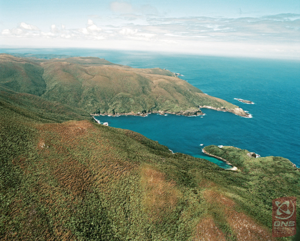
Photo Credit: 95266 - Lloyd Homer – GNS Science | Te Pū Ao – All rights reserved
Cook and those on board the HMB Endeavour had been sent south to prove or disprove the theory of a great southern continent. From the journals of those on board, naturalist Joseph Banks appears to have held on to the idea the longest. As the Endeavour sailed along the south-eastern coast of the South Island [Te Waipounamu] and down to Stewart Island/Rakiura, Banks recorded the ongoing debates between the ‘no continents’ and the ‘continents’, although he admits that the latter group contained himself and ‘one poor midshipman’ while ‘the rest begin to sigh for roast beef’ and wished to head home.
Throughout early March 1770, his journal records brief hope that a continent might be there, only for those hopes to be dashed. On 6 March, he said the land stretched so far to the south, that men began to believe there might be a continent after all. But three days later, a large swell from the southwest began to disprove this theory. On 10 March, the wind blew them around a point of land ‘to the total demolition of our aerial fabrick [called] continent’.
As the Endeavour rounded the South Cape (so named by Cook) and headed up the west coast of Stewart Island/Rakiura, the idea that New Zealand might be a continent was finally dispelled.
The Ngāi Tahu Kā Huru Manu online atlas states South Cape was traditionally known as Ōpēhia and Whiore, with Ōpēhia also being the Māori name for nearby Nicholson Harbour.
In 1998, Whiore was restored to the official dual name as part of the Ngāi Tahu Claims Settlement Act. It is now officially South Cape/Whiore.
References
- NZ Gazetteer -South Cape/Whiore
- Joseph Banks, ‘24 February 1770’, South Seas: Voyaging and Cross-Cultural Encounters in the Pacific (1760-1800)
- Joseph Banks, ‘6 March 1770’, South Seas: Voyaging and Cross-Cultural Encounters in the Pacific (1760-1800)
- Joseph Banks, ‘9 March 1770’, South Seas: Voyaging and Cross-Cultural Encounters in the Pacific (1760-1800)
- Joseph Banks, ‘10 March 1770’, South Seas: Voyaging and Cross-Cultural Encounters in the Pacific (1760-1800)
- Nga Tahu Kā Huru Manu
- ‘Ngāi Tahu Claims Settlement Act 1998’